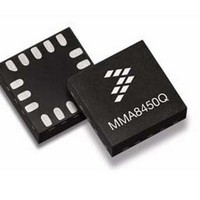MMA8450QT Freescale Semiconductor, MMA8450QT Datasheet - Page 13

MMA8450QT
Manufacturer Part Number
MMA8450QT
Description
Board Mount Accelerometers 12bit 3-Axis FIFO HPF PL
Manufacturer
Freescale Semiconductor
Specifications of MMA8450QT
Sensing Axis
X, Y, Z
Acceleration
2 g, 4 g, 8 g
Digital Output - Number Of Bits
12 bit
Supply Voltage (max)
1.89 V
Supply Voltage (min)
1.71 V
Supply Current
3 uA
Maximum Operating Temperature
+ 85 C
Minimum Operating Temperature
- 40 C
Shutdown
Yes
Sensitivity
0.976 mg/digit, 1.953 mg/digit, 3.906 mg/digit
Package / Case
QFN-16
Output Type
Digital
Package Type
QFN
Operating Temperature (min)
-40C
Operating Temperature (max)
85C
Operating Temperature Classification
Industrial
Product Depth (mm)
3mm
Product Height (mm)
1mm
Product Length (mm)
3mm
Mounting
Surface Mount
Pin Count
16
Acceleration Range
± 2g, ± 4g, ± 8g
No. Of Axes
3
Ic Interface Type
I2C, Serial
Sensor Case Style
QFN
No. Of Pins
16
Supply Voltage Range
1.71V To 1.89V
Rohs Compliant
Yes
Lead Free Status / RoHS Status
Lead free / RoHS Compliant
Available stocks
Company
Part Number
Manufacturer
Quantity
Price
Company:
Part Number:
MMA8450QT
Manufacturer:
RALINK
Quantity:
2 940
Part Number:
MMA8450QT
Manufacturer:
FREESCALE
Quantity:
20 000
3
3.1
gravitational field. The sensitivity of the sensor can be determined by subtracting the -1g acceleration value from the +1g
acceleration value and dividing by two.
3.2
sensor in a steady state on a horizontal surface will measure 0g in X-axis and 0g in Y-axis whereas the Z-axis will measure 1g.
The output is ideally in the middle of the dynamic range of the sensor (content of OUT registers 0x00, data expressed as 2's
complement number). A deviation from ideal value in this case is called Zero-g offset. Offset is to some extent a result of stress
on the MEMS sensor and therefore the offset can slightly change after mounting the sensor onto a printed circuit board or
exposing it to extensive mechanical stress.
3.3
electrostatic actuation force is applied to the sensor, simulating a small acceleration. In this case the sensor outputs will exhibit
a change in their DC levels which are related to the selected full scale through the device sensitivity. When Self-Test is activated,
the device output level is given by the algebraic sum of the signals produced by the acceleration acting on the sensor and by the
electrostatic test-force.
4
transitioning from Standby to Active. These are all noted in the device memory map register table. For more detail on how to use
the Sleep and Wake modes and how to transition between these modes, please refer to the functionality section of this document.
Sensors
Freescale Semiconductor
Table 7. Mode of Operation Description
SHUTDOWN
Sensitivity describes the gain of the sensor and can be determined by applying a g acceleration to it, such as the earth's
Zero-g Offset describes the deviation of an actual output signal from the ideal output signal if no acceleration is present. A
Self-Test checks the transducer functionality without external mechanical stimulus. When Self-Test is activated, an
All register contents are preserved when transitioning from Active to Standby mode. Some registers are reset when
STANDBY
ACTIVE
Mode
OFF
SHUTDOWN
Terminology
Sensitivity
Zero-g Offset
Self-Test
Modes of Operation
Mode
Mode
OFF
Powered Down
I
I
I
2
2
2
C communication ignored
C communication possible
C communication possible
I
2
C Bus State
EN = VDD & VDD = ON
Figure 6. MMA8450Q Mode Transition Diagram
VDD = OFF
<1.5 V
VDD
ON
ON
ON
EN = GND
<VDD + 0.3 V
EN = Low
EN = VDD
Standby register set
EN = VDD
Standby register reset
EN
STANDBY
Mode (00)
Mode (01)
WAKE
The device is powered off.
All analog & digital blocks are shutdown.
Only POR and digital blocks are enabled.
Analog subsystem is disabled.
Registers accessible for Read/Write.
Device configuration done in this mode.
All blocks are enabled (POR, digital, analog).
Function Description
Mode (10)
SLEEP
MMA8450Q
13












